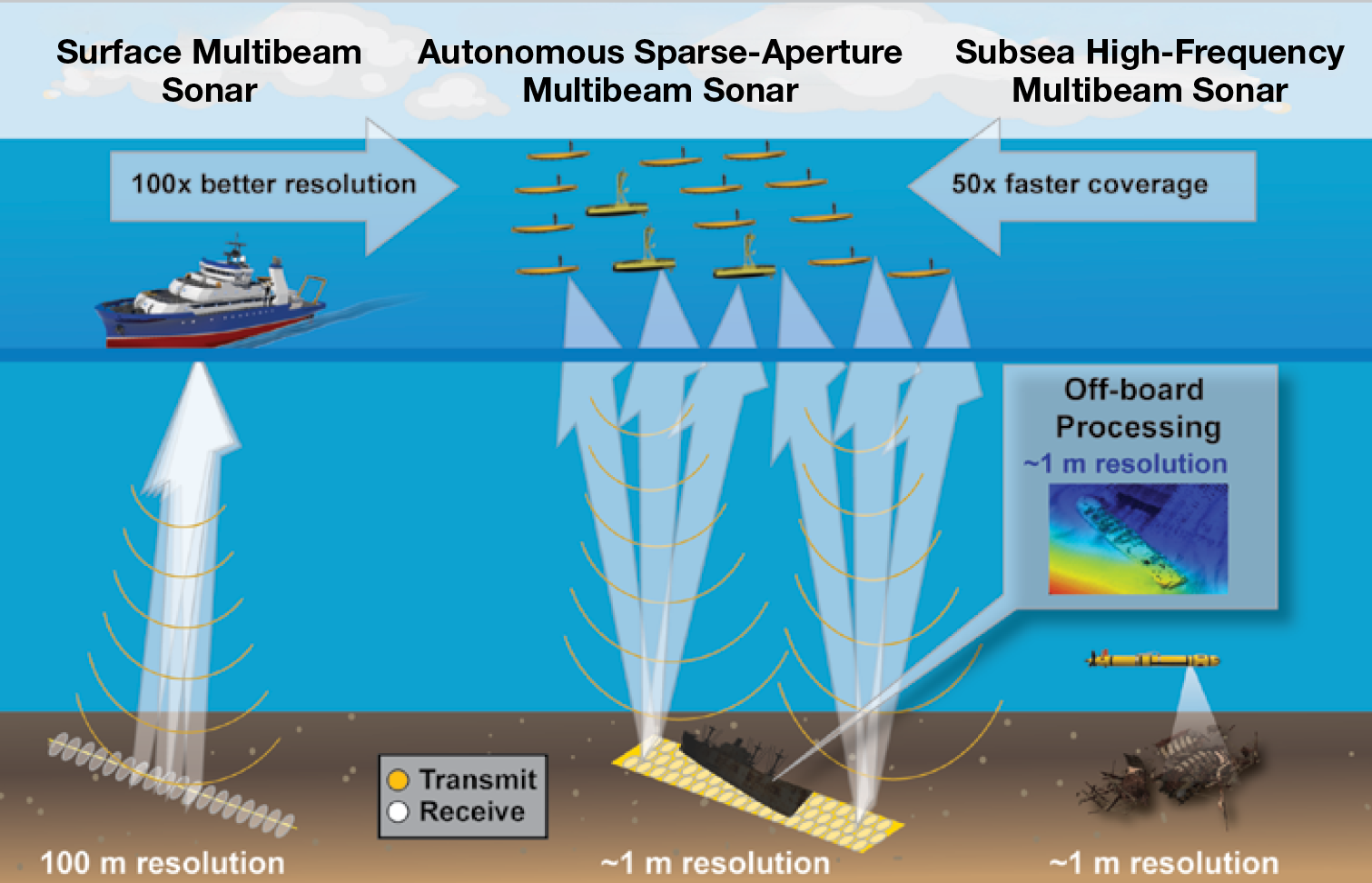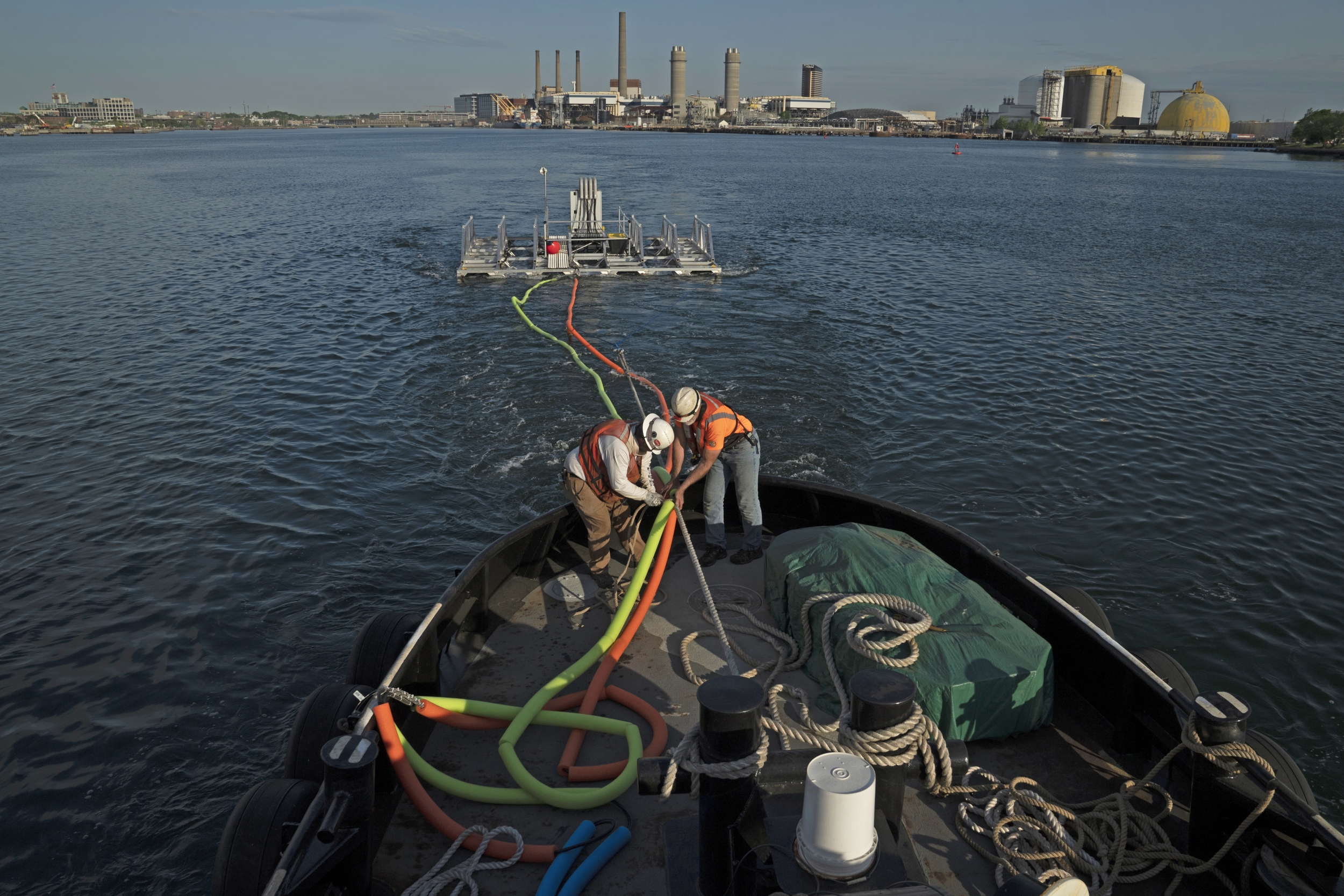Improving Deep-Sea Mapping with an Autonomous Sonar Array

Researchers at Lincoln Laboratory and the MIT Department of Mechanical Engineering developed a novel concept to allow investigators to locate objects submerged deep in the ocean and gain insight into deep-sea environs. The team’s innovative estimation algorithms, acoustic signal processing, and precision-navigation techniques enable a swarm of sonar-equipped autonomous surface vessels to obtain high-resolution images of the ocean floor. This concept demonstrated capabilities greatly improved over traditional options for ocean mapping: higher-resolution imaging than that attained by a sonar system mounted on a ship’s hull, and faster coverage rate than that achieved by sonar installed on a single autonomous underwater vehicle.

The autonomous sparse-aperture concept (center) offers a potential 100-fold improvement in resolution compared to that of existing surface-ship multibeam sound navigation and ranging systems, i.e., sonar, (at left) and a potential
50-fold increase in coverage rate compared with that of subsea sonars (at right).
Motivation
Oceans cover 71% of Earth’s surface, but more than 80% of ocean depths remain unexplored or represented by low-quality maps. Current imaging technology working from the ocean surface (primarily hull-mounted sonar) is capable of identifying manmade objects or natural features on the seabed at a maximum range of less than 1,000 meters through water. Because water absorbs high-frequency sounds, sonar carried on a ship hull operates at a low-frequency that results in low-resolution imagery. A sonar integrated on an autonomous undersea vehicle (AUV) can attain good resolution of a deep, limited area, but an AUV is expensive, time-consuming to deploy, and slow moving.
Innovative Solution
For a sonar array operating at the ocean surface to attain resolution comparable to that of an undersea imaging system, its aperture would have to be 100 times larger than that of an array installed on a hull. To achieve a sonar array that large and both feasible and cost-effective, our novel concept proposes putting small sonar systems on separate autonomous surface vessels (ASVs). The acoustic signals from all ASVs are collected, and their source locations are measured/estimated relative to the locations of all ASVs. By combining all signals and coordinating them with their relative positions, a high-resolution map of the ocean floor can be constructed. A small swarm of about 20 ASVs creates a large (hundreds of meters by hundreds of meters), sparsely deployed sonar array that maps the ocean floor at longer ranges than currently achievable. Acoustic signal processing and new estimation algorithms, including Bayesian and artificial intelligence techniques, mitigate both the impacts of the array’s lower signal-to-noise ratio and much of the noise coming from unwelcome directions. Data processing for all required control and calculations can be completed remotely on a companion ship or onshore platform.

In 2021, researchers deployed a rigid frame on which a technology demonstrator undersea-mapping sparse sonar array was mounted for sea tests of the array’s capability intended to provide resolution two orders of magnitude higher than currently achievable.
Benefits
- Allows imaging of a wide area of the seabed
- Achieves high-quality image resolution comparable to that of a sonar carried on an underwater vehicle
- Lowers operating costs and increases continuity of observations because the system runs autonomously for months, without needing regular port resupply visits
- Uses cost-effective small sonar systems and autonomous surface vessels
Additional Resources
Video: Autonomous Sparse-Aperture Multibeam Echo Sounder
P. Ryu et al., “A Wide-Area Deep Ocean Floor Mapping System: Design and Sea Tests,” Geomatics, vol. 3, 22 March 2023.
NEWS: Surface-based sonar system could rapidly map the ocean floor at high resolution
2024 R&D 100 Award winner